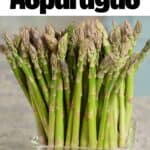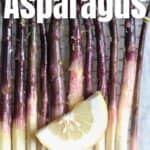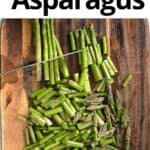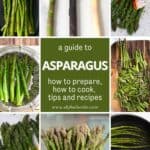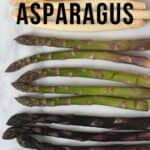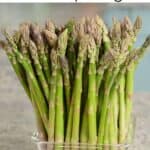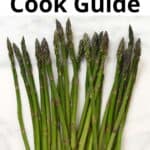This post may contain affiliate links. Please read our disclosure policy.
How to cook asparagus in 7 ways: steamed, boiled, roasted, broiled, air fried, sautéed, or grilled – with simple step-by-step instructions for prepping and cooking + FAQs!
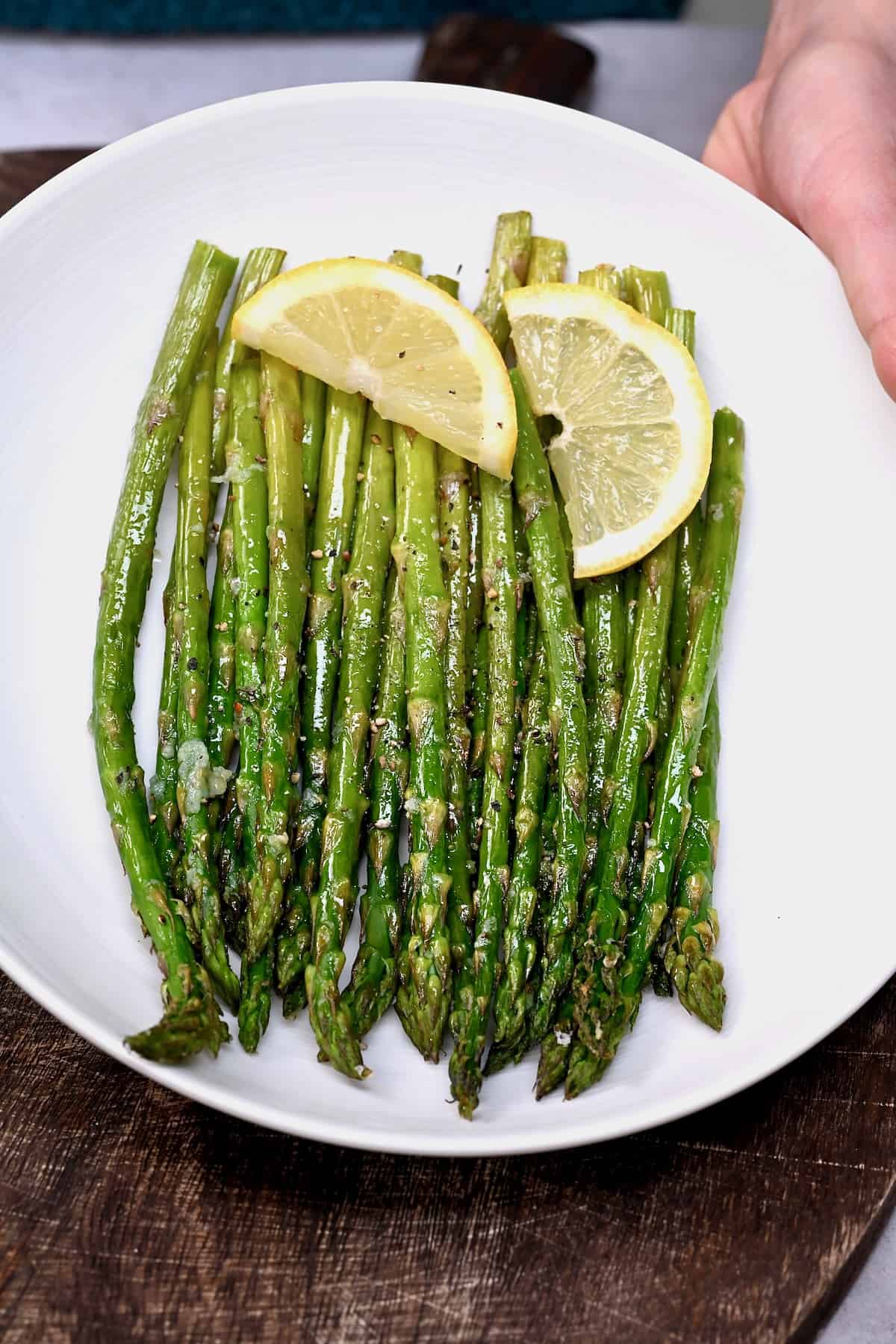
Asparagus is one of my favorite spring vegetables. When cooked well, it’s perfectly tender-crisp, vibrant, with a slightly earthy yet sweet taste I love. Cooked badly, it can become waterlogged and mushy. That’s why I’ve pulled together my top 7 methods for how to cook asparagus!
Asparagus is a low-calorie yet nutrient-dense vegetable loaded with antioxidants, prebiotic fiber, and plenty of vitamins and minerals. That makes it a healthy and versatile side for dozens of dishes – poached eggs, garlic lemon pasta, mushroom risotto, air fried salmon, air fryer steaks, etc.
Not only does it cook in as little as just a few minutes in some cases, but this ingredient requires just a little prep and not much more than salt & black pepper to make its flavors shine (though a little garlic, lemon, butter, and/or parmesan will never go amiss!). Looking for more ways to enjoy asparagus? Check out my cream of asparagus soup or quick pickled asparagus recipes.
Want to save this recipe?
How to select the best fresh asparagus
There are three things to remember when picking asparagus:
- Texture: Fresh asparagus will be firm to the touch and able to stand up straight. It should feel smooth, with a compact/tight tip. If it’s wilting, limp, or soft, it’s not fresh.
- Color: You’re looking for a rich green color that turns white as you get to the bottom of the stalk. The tips of the asparagus may also be dark green or purple.
- Size: Asparagus comes in a variety of sizes and thicknesses – usually thin, medium, and thick. Try to pick bundles that are similar in size and color.
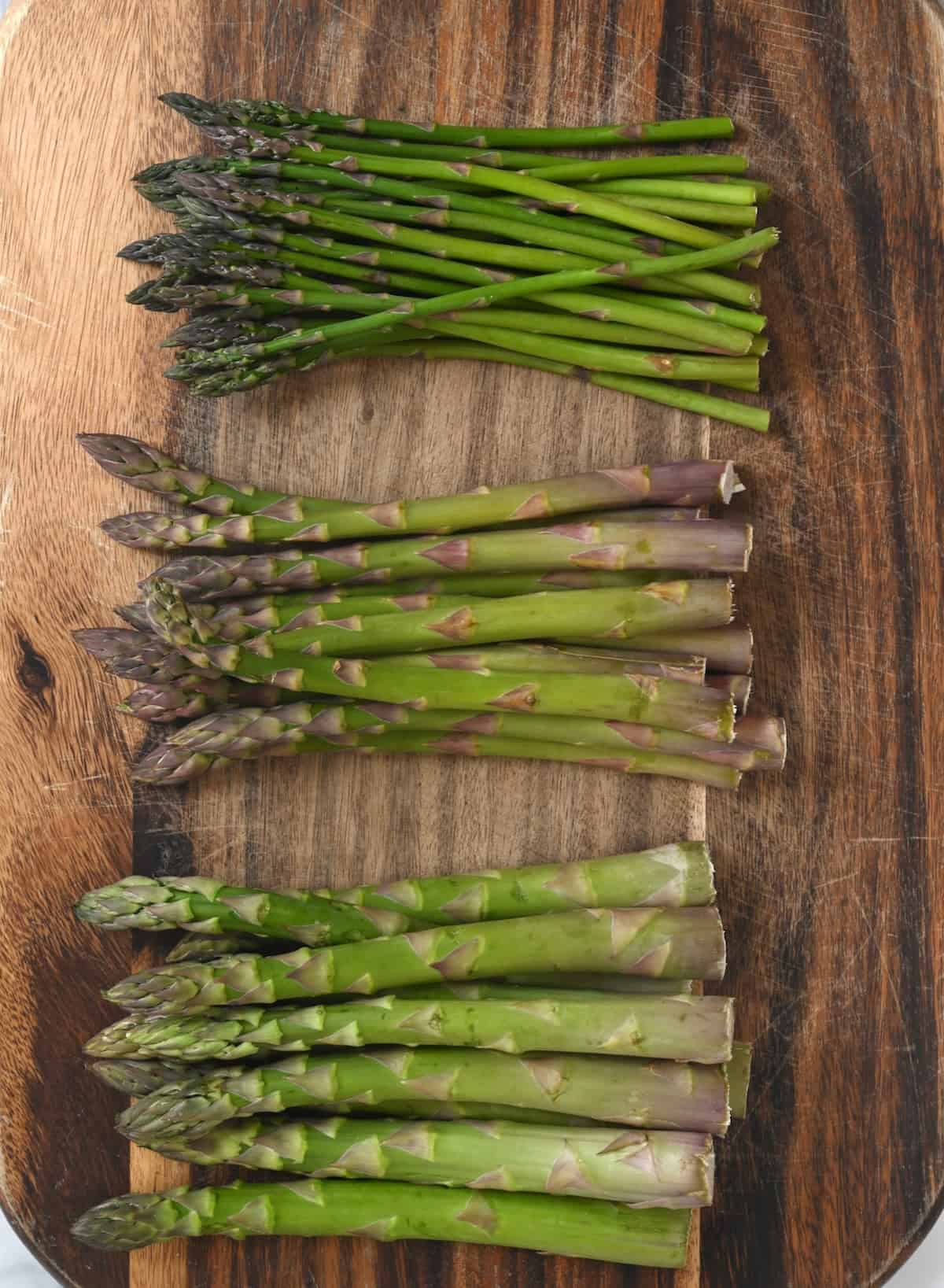
Note: there are three types of asparagus: green, white, and purple. Purple can be treated the same as green asparagus, but white asparagus must be peeled and well-cooked (not until just tender-crisp).
How to prepare asparagus
First up, before cooking asparagus, comes how to prepare asparagus. Don’t skip trimming the stalks. Otherwise, you may end up with a mouthful of woody, fibrous pieces!
- Wash the asparagus in a large bowl of water, swishing it around, as the spears can hide grit/sand in the crevices. Then pat them dry.
- Then it’s time to trim them. The quickest way to trim asparagus is to bend a single stalk near where the green is fading into white. The stalk should naturally snap at the correct point to remove the woody ends.
- Using a sharp knife, then line up the ends of a handful of asparagus spears (at a time) and trim them all in the same spot.
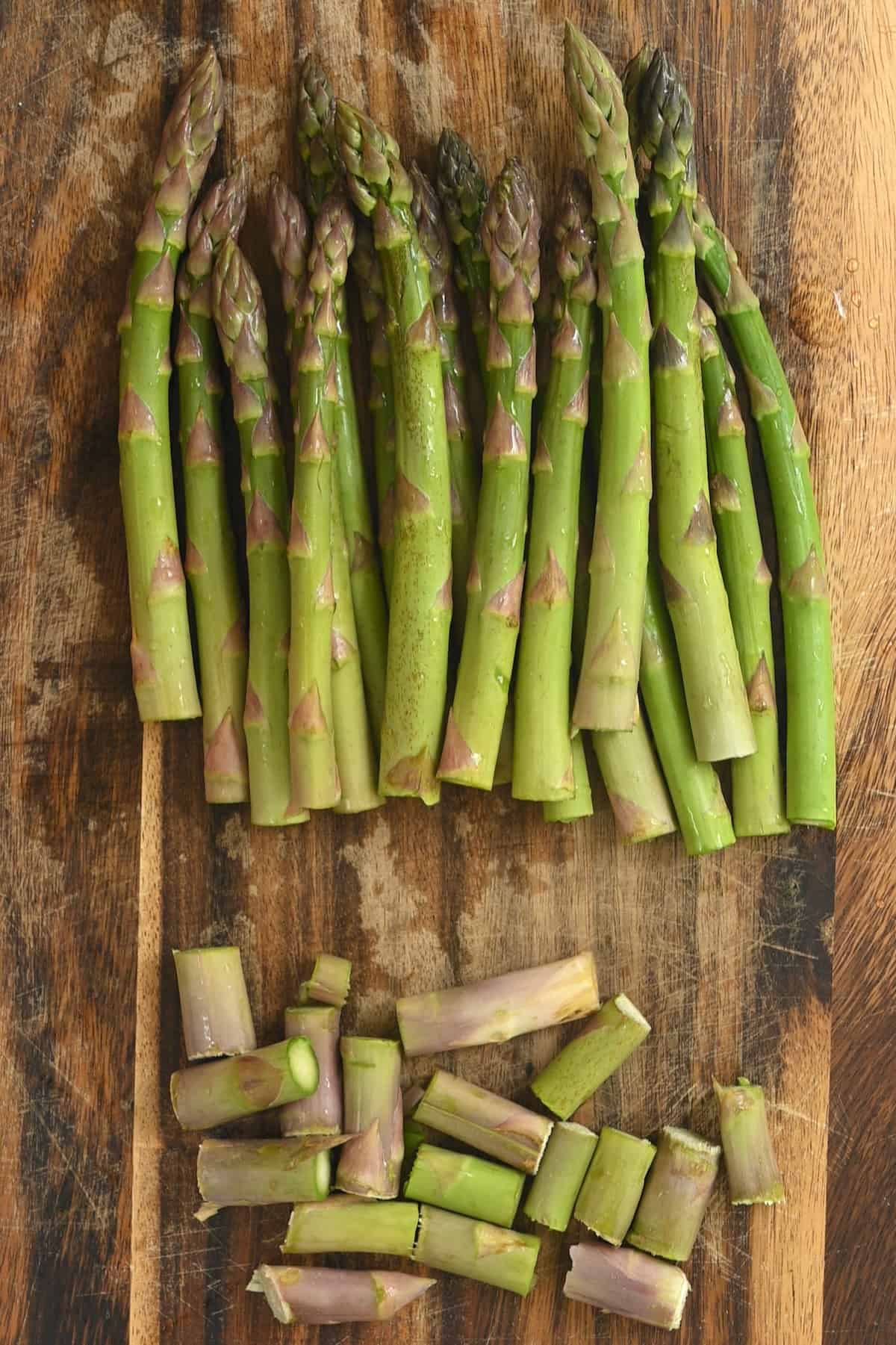
If you have really thick spears, their peel can be fairly tough. If so, place a spear flat on your work surface and use a vegetable peeler to peel about halfway up the spear. Repeat with the remaining spears.
How to cook asparagus
Choose from 7 easy ways to cook asparagus based on the time, tools, and effort level you’d prefer.
Steamed Asparagus
You can steam asparagus on the stovetop in minutes for perfectly tender-crisp, flavorful results. Plus, this method helps preserve many of its water-soluble vitamins (unlike boiling).
- Bring about an inch of water to a boil in a large saucepan (or use a multi-teared steaming pan/steamer), then reduce the heat to a simmer and place a steamer basket/insert within the pot, with the asparagus inside it.
- Cover the pot with a lid and steam the asparagus until vibrant and tender-crisp. This can take 4-10 minutes, depending on the thickness of the asparagus stalks.
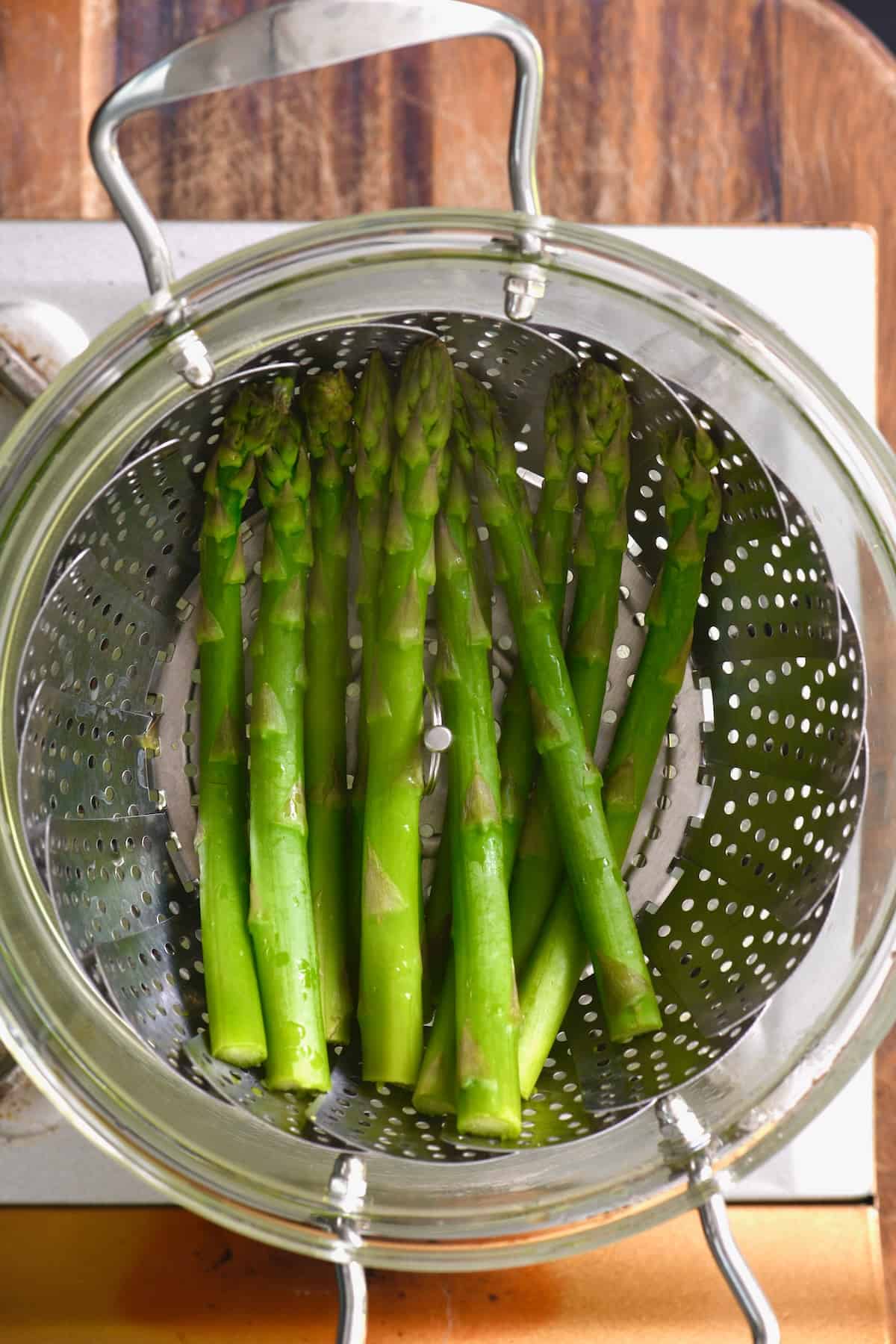
Alternatively, steam asparagus in a microwave by placing it in a single layer in a lidded microwave-safe container. Cover and cook on high for 3-4 minutes until tender-crisp.
Boiled Asparagus
Boiling asparagus is super quick and easy. Just make sure not to overcook the stalks; otherwise, they may become waterlogged/mushy.
- Bring a pot of water (enough to submerge the asparagus without overflowing) to a boil and add the asparagus.
- Boil for 3-5 minutes (up to 7 for super thick stalks) until tender-crisp.
- Then drain, season, and enjoy.
If you’re just looking to blanch asparagus, cook it at a rapid simmer in well-salted water for 1 minute, then immediately transfer it to a bowl of ice water (with tongs) to halt the cooking process.
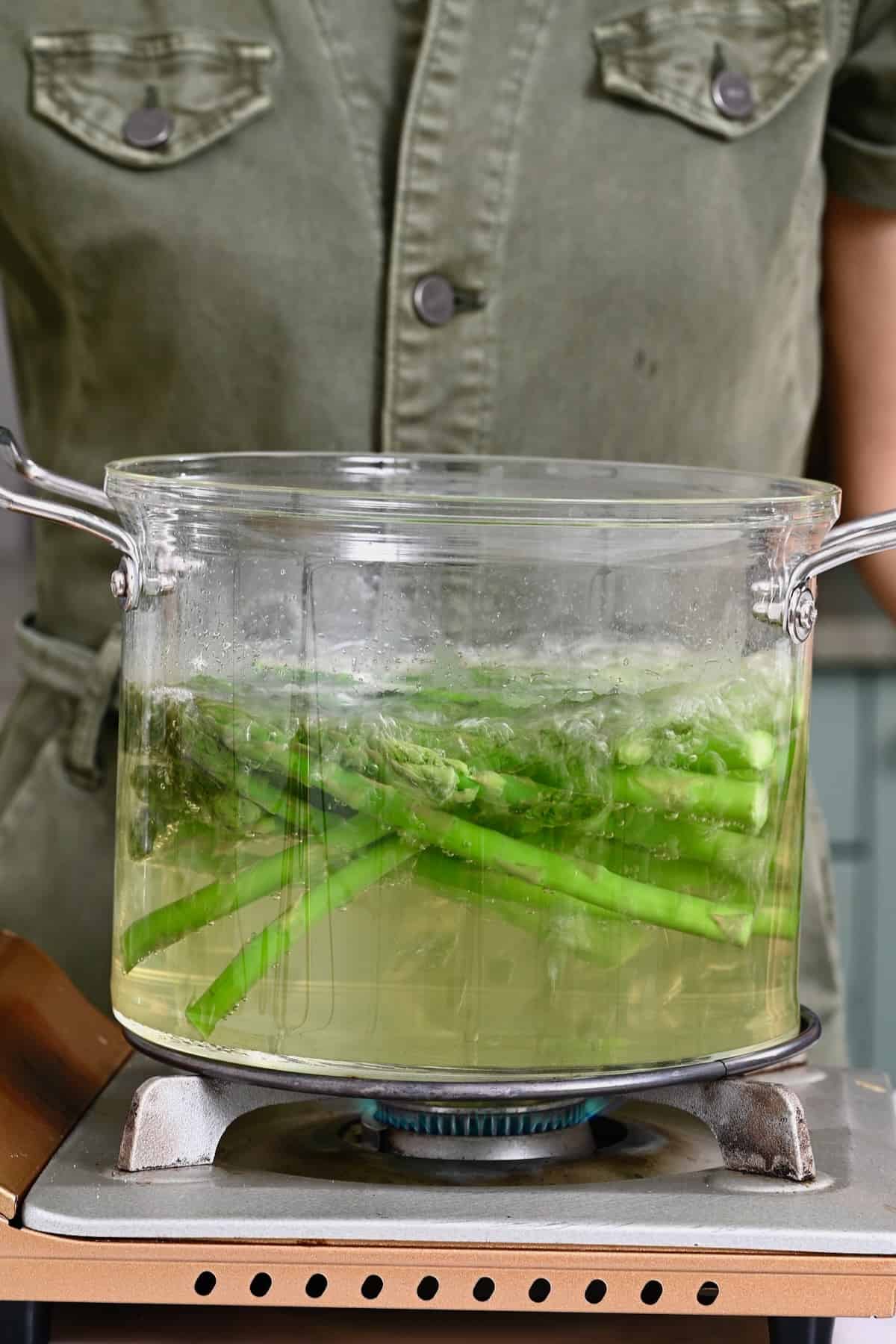
Roasted Asparagus
While roasting asparagus takes the longest time, cooking asparagus in the oven helps caramelize the veggie, adding a slightly crisp texture and a heap of extra flavor.
- Preheat the oven to 400ºF/200ºC.
- Arrange the asparagus on a baking tray with space between, drizzle with olive oil, and season with salt & pepper.
- Roast the asparagus until tender-crisp inside with lightly browned, caramelized edges, shaking the pan halfway.
- Thin: 8-11 minutes,
- Medium: 12-15 minutes,
- Thick: 16-20 minutes.
Toss the roasted asparagus with butter or a sprinkle of parmesan cheese for even more flavor when serving. For more tips, check my dedicated post for roasted asparagus.
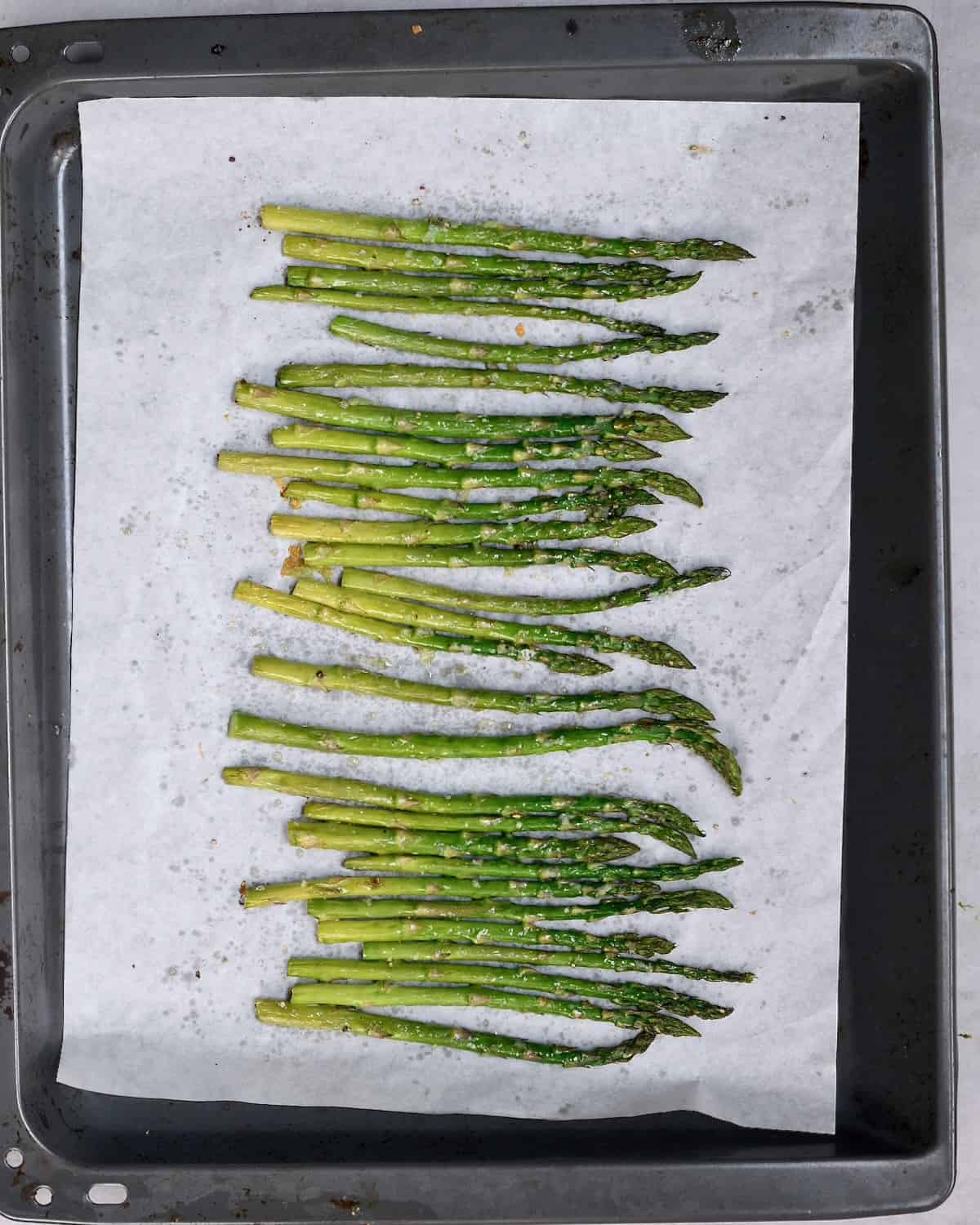
Broiled Asparagus
This method adds more char and crisp texture than roasting asparagus and is ready in under 15 minutes.
- Preheat the broiler to high. Meanwhile, toss the asparagus spear with salt, pepper, and olive oil.
- Spread the spears in a single layer across a baking sheet and place it about 6 inches beneath the heating element.
- Broil until lightly browned and tender (about 8-10 minutes), flipping every few minutes to avoid burn.
Air Fryer Asparagus
Learn how to cook fresh asparagus in an air fryer to achieve the same roasted results in a fraction of the time (here is my full method and tips for how to air fry asparagus).
- Toss the spears with salt, pepper, and olive oil.
- Arrange the asparagus in a single layer with minimal overlapping.
- Air fry at 400ºF/200ºC until tender crisp, and lightly golden brown on the edges.
- Thin: 3-5 minutes,
- Medium: 6-9 minutes,
- Thick: 10-15 minutes.
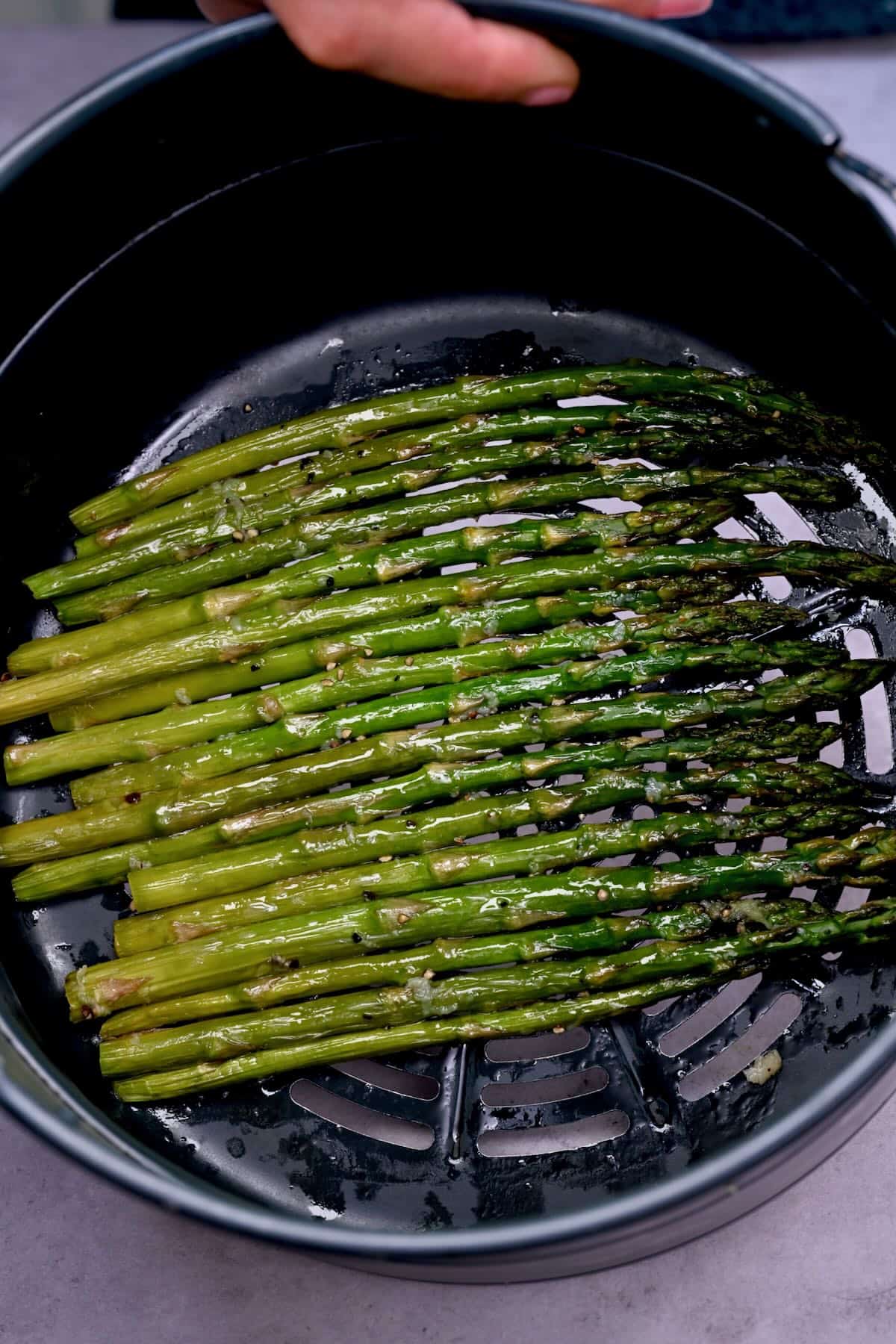
Sauteed Asparagus
Sautéed asparagus is super simple and adds an extra buttery flavor you’ll adore. Thin and medium spears work best. Note this method is practically identical when using a wok for stir-frying asparagus.
- Melt butter in a large skillet over medium-high heat.
- Add the asparagus stalks (whole or chopped into smaller pieces) and sauté for 5-10 minutes until tender-crisp (the exact time will vary based on their thickness). See more details and tips on my post on how to sauté asparagus.
I highly recommend adding a squeeze of lemon juice before serving. This version of cooked asparagus also pairs wonderfully with fresh herbs and garlic.
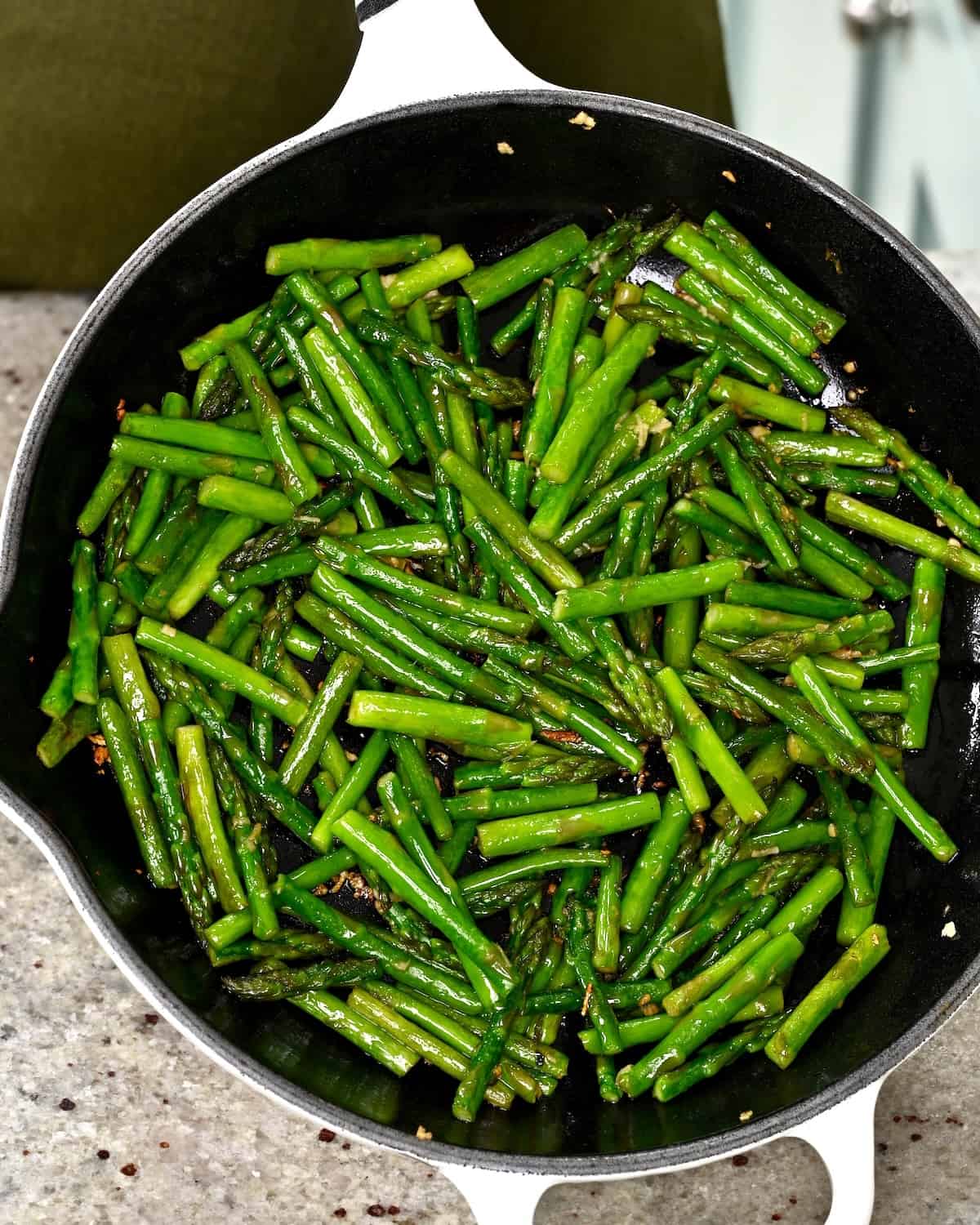
Grilled Asparagus
Nothing beats fresh asparagus grilled to perfection. This easy recipe brings out its natural sweetness while adding a tasty smoky touch in just minutes.
- Drizzle the asparagus with olive oil, then sprinkle with salt and pepper. Toss well to coat evenly.
- Preheat your grill to high heat.
- Lay the asparagus spears across the grill grates to prevent them from falling through.
- Grill for 3 to 5 minutes, turning occasionally with tongs, until tender and lightly charred.
See more details in my grilled asparagus recipe.
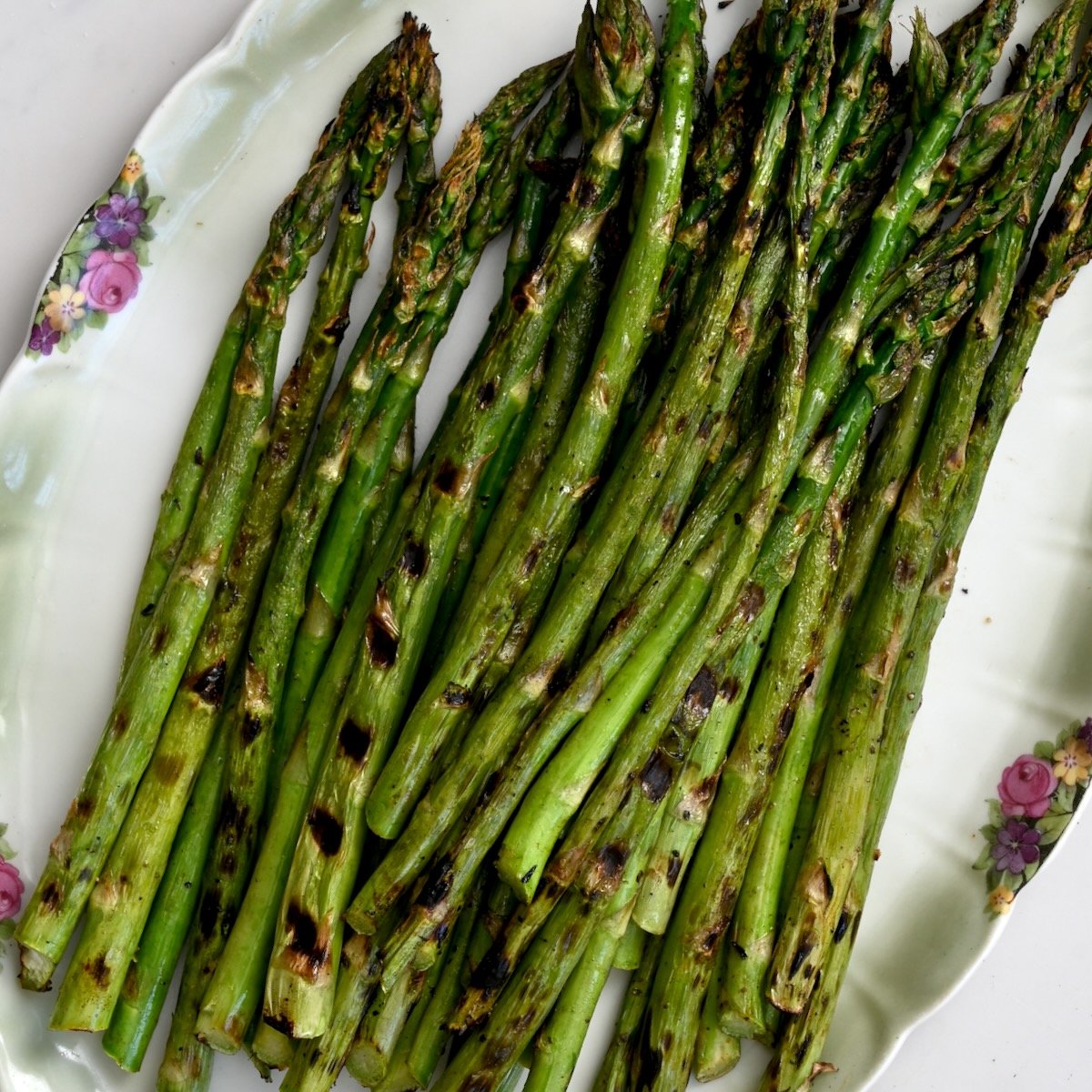
After trying out these easy methods to cook asparagus, you might also like to know how to keep asparagus fresh in the refrigerator and how to freeze asparagus.
More ingredient guides and how-tos
- What Is Artichoke and How to Cook It
- How to Cook Broccoli in 6 Easy Ways
- What Is Fennel and How to Cook It
- Radishes and What to Do with Them
- How to Cut Leeks and How to Cook Them
If you try any of these different ways to cook asparagus, let me know how it goes in the comments below. I’d appreciate a recipe card rating and would love to see your recipe recreations – tag me on Instagram @Alphafoodie!
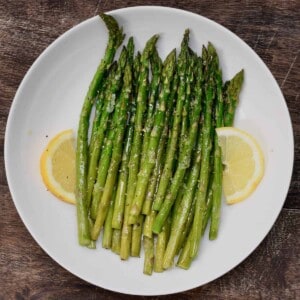
How to Cook Asparagus 7 Ways
Ingredients
- 14 oz asparagus fresh is best
- 1 Tbsp olive oil or butter, if needed for roasting or sautéing
- water if needed for steaming or boiling
Instructions
Prepare the Asparagus
- Wash the asparagus in a large bowl of water, swishing it around, as the spears can hide grit/sand in the crevices. Then pat them dry.
- Trim the stalks. The quickest way to do so is to bend a single stalk near where the green is fading into white. The stalk should naturally snap at the correct point to remove the woody ends.Using a sharp knife, then line up the ends of a handful of asparagus spears (at a time) and trim them all in the same spot.If you have really thick spears, their peel can be fairly tough, too. If so, place a spear flat on your work surface and use a vegetable peeler to peel about halfway up the spear. Repeat with the remaining spears.
Steamed Asparagus
- Bring about an inch of water to a boil in a large saucepan (or use a multi-teared steaming pan/steamer), then reduce the heat to a simmer and place a steamer basket/insert within the pot, with the asparagus inside it.
- Cover the pot with a lid and steam the asparagus until vibrant and tender-crisp. This can take 4-10 minutes, depending on the thickness of the asparagus stalks.
Boiled Asparagus
- Bring a pot of water (enough to submerge the asparagus without overflowing) to a boil and add the asparagus.
- Boil for 3-5 minutes (up to 7 for super thick stalks) until tender-crisp.Then drain, season, and enjoy.
Roasted Asparagus
- Preheat the oven to 400ºF/200ºC.
- Arrange the asparagus on a baking tray with space between, drizzle with olive oil, and season with salt & pepper.
- Roast the asparagus until tender-crisp inside with lightly browned, caramelized edges, shaking the pan halfway.– Thin: 8-11 minutes,– Medium: 12-15 minutes,– Thick: 16-20 minutes.Toss the roasted asparagus with butter or a sprinkle of parmesan cheese for even more flavor when serving.
Broiled Asparagus
- Preheat the broiler to high. Meanwhile, toss the asparagus spear with salt, pepper, and olive oil.
- Spread the spears in a single layer across a baking sheet and place it about 6 inches beneath the heating element.
- Broil until lightly browned and tender (about 8-10 minutes), flipping every few minutes to avoid burn.
Air Fryer Asparagus
- Toss the spears with salt, pepper, and olive oil.
- Arrange the asparagus in a single layer with minimal overlapping.
- Air fry at 400ºF/200ºC until tender crisp, and lightly golden brown on the edges.– Thin: 3-5 minutes,– Medium: 6-9 minutes,– Thick: 10-15 minutes.
Sautéed Asparagus
- Melt butter in a large skillet over medium-high heat.
- Add the asparagus stalks (whole or chopped into smaller pieces) and sauté for 5-10 minutes until tender-crisp (the exact time will vary based on their thickness).
Roasted Asparagus
- Toss asparagus with olive oil, salt, and pepper.
- Preheat grill to high. Lay spears across the grates to prevent slipping.
- Grill 3–5 minutes, turning occasionally, until tender and lightly charred.
Notes
Nutrition
Nutrition information is automatically calculated, so should only be used as an approximation.

